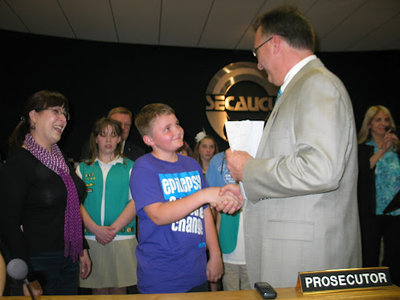Nine-year-old Donald Cieciuch stood quietly on Tuesday in front of a room packed with peers, residents, and members of the Town Council as the town proclaimed Mar. 26 “Purple Day” to raise awareness about epilepsy.
Epilepsy is a condition of the brain that is characterized by recurrent seizures.
Cieciuch wore a bright purple shirt that read “Epilepsy Educate Change,” the same kind of shirt that will be worn by others across the globe as part of a worldwide movement to end the stigma surrounding the disorder. It was Cieciuch’s willingness to step forward about his own condition that led to the town’s declaration.
“I am proud to be here with Donald, who is a fantastic role model and will help others,” said Debra Josephs, executive director of the Anita Kaufmann Foundation. She has served eight years at the helm of the organization that educates the public not to fear people with epilepsy.
She added, “Secaucus is such a wonderful town and should lead all of New Jersey in this campaign to educate the public not to fear people with epilepsy.”
“We want to thank Mayor [Michael] Gonnelli and the Town Council for taking the time to raise awareness about epilepsy and for the proclamation,” said Donald’s father, Raymond Cieciuch before the meeting. Raymond is a volunteer firefighter and former Fire Department chief.
March 26 is called “Purple Day” after lavender, which is the international color for epilepsy.
A hidden condition
Cieciuch carries himself with a calm disposition and seems like an average 9-year-old boy. A fourth grade high honors student, he attends Huber Street Elementary School and plays travel basketball and Little League while also pursuing creative interests such as the Dance Club and band.
“He is an average kid. He is funny. He is outgoing,” said Donald’s mother, Victoria Cieciuch. “You wouldn’t even know he had epilepsy by looking at him or talking to him.”
Three years ago, Donald had a seizure while he was sleeping. Doctors initially thought he had a high fever. But shortly thereafter he suffered his second seizure. He was diagnosed with epilepsy at Hackensack University Medical Center.
“His seizures usually come at night when he is sleeping,” said Victoria. She said he gets what is referred to as an aura; a strange sensation in his legs that warns him a seizure is coming on. Victoria said that his medication helps keep the seizures under control.
She said that most children outgrow Donald’s type of epilepsy, called Benign Rolandic Epilepsy, by the time they reach puberty. This type of epilepsy affects one out of five children diagnosed with the disorder.
“I know that there are other children in Secaucus that have it,” said Victoria. She said that once she began to come forward about the fact that Donald has epilepsy, people began to “come out of the wood work” and share stories about their own experiences with the condition.
“The only people who will change the face of epilepsy are the people with epilepsy.” – Debra Josephs
__________
Educating the public
Despite the fact that epilepsy affects 3 million Americans and 50 million people worldwide, many remain in the dark about what to do if someone has a seizure.
“A lot of people are so afraid of it,” said Victoria. “There is really nothing to fear.”
Anita Kaufmann, a former New Jersey resident who passed away in 2003, experienced discrimination because she had epilepsy. Kaufmann was made to leave a vacation spa when she experienced her first seizure. “They told her not to come back again,” said Josephs, Kaufmann’s best friend. “She thought the discrimination was worse than the condition itself.”
One out of 10 people will experience a seizure in their lifetime.
“No one knows how to help them – that is a problem,” said Josephs. She said that people mistakenly believe that they should put something in a person’s mouth or hold them down. Josephs said people should remain calm, move dangerous objects out of the way, time the seizure, turn the person on their side if on the ground, and call 911 (particularly if the seizure lasts longer than five minutes). She said bookmarks describing seizure first aid are available throughout Secaucus.
Changing the face of epilepsy
“The only people who will change the face of epilepsy are the people with epilepsy,” said Josephs. “One day we hope that people with epilepsy will be accepted in much the same way as people with glasses are today.”
A 9-year-old girl named Cassidy Megan of Nova Scotia, Canada founded Purple Day in 2008 with the help of the Epilepsy Association of Nova Scotia. She wanted people with epilepsy to know that they are not alone. Like Cassidy, Donald has let the children of Secaucus who have epilepsy know that he stands by them.
For more information visit: http://www.purpleday.org . To learn about the Anita Kaufmann Foundation, visit: http://www.akfus.org.
Adriana Rambay Fernández can be reached at afernandez@hudsonreporter.com.
